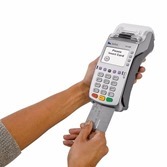Card readers are devices that are used to read the various types of cards which are widely used in ATM’s, banks, restaurants, businesses, photography (memory card) and mobile phones. When we talk about cards here, we do not only mean debit cards or credit cards. We also mean cards that are used to get entry into a room or to show your identity.
Since there are different types of cards, there are different types of card readers as well.
Here are a 5 types of card readers which are commonly used:
Proximity Card Readers
The most well-known card reader is called Proximity card reader. These readers utilize cards or tokens as a methods for distinguishing identity proof.
As the name suggests, no immediate contact is required between the card and the reader for the system to work, the card should just be in the vicinity of the reader. The read range depends on the card/token and the kind of reader being used; it can be as low as 1/2 inch, and as high s 3 feet.
The reader produces a RF field which makes the wires inside the card to resound, exchanging the card data to the reader. These cards are insusceptible to electromagnetic and RF interference, therefore, no contact is required.
Wiegand Card Reader
These cards when embedded or swiped through the card reader generate an electromagnetic field that regulates a voltage in the card making it transmit its code.
These readers work for a longer period of time as they are weather proof. These cards are also hard to copy, therefore, they are safe to use.
Magnetic Card Reader
These card readers use a similar innovation that is utilized in credit card technology and are likely the most widely recognized kind of card being used today.
There are two sorts of magnetic cards, low-coercivity, and high-coercivity. The high-coercivity sort is less inclined to coincidental deletion and harm. Magnetic stripe cards require that the card comes into direct contact with the lintechtt, thus, bringing about wear and tear and can have a shorter life expectancy. This immediate contact necessity can also bring misreads because of dirt accumulation in the reader.
The cards are low in cost, however, they are effortlessly copied, are influenced by outside attractive fields, and the readers require infrequent cleaning to expel any dirt development on the read heads. They are also not as safe as the other cards in terms of fraud, however they are still heavily used due to their advantages, mainly low cost.
Barcode Reader
Barcode readers use bars and spaces of various widths and lengths to read the data. This is a similar technology that is utilized by stores for stock control and counters. Since the scanner tag is obvious it is anything but difficult to copy and in that capacity is not thought to be a decent decision for systems where security is a noteworthy concern.
Keypad Readers
Keypads utilize a numeric pad similar to a phone’s. The client squeezes his code into the keypad and the reader reads the numbers. This system does not require the client to convey any exceptional card or token, however, it can be less secure, since number being entered can be seen by a third party.
Certain keypads overcome this downside by scrambling the number design each time the keypad is utilized.

